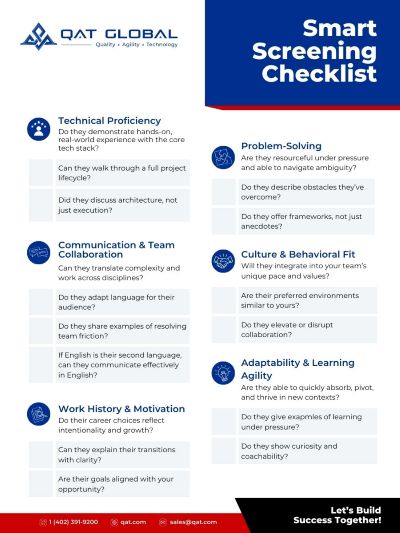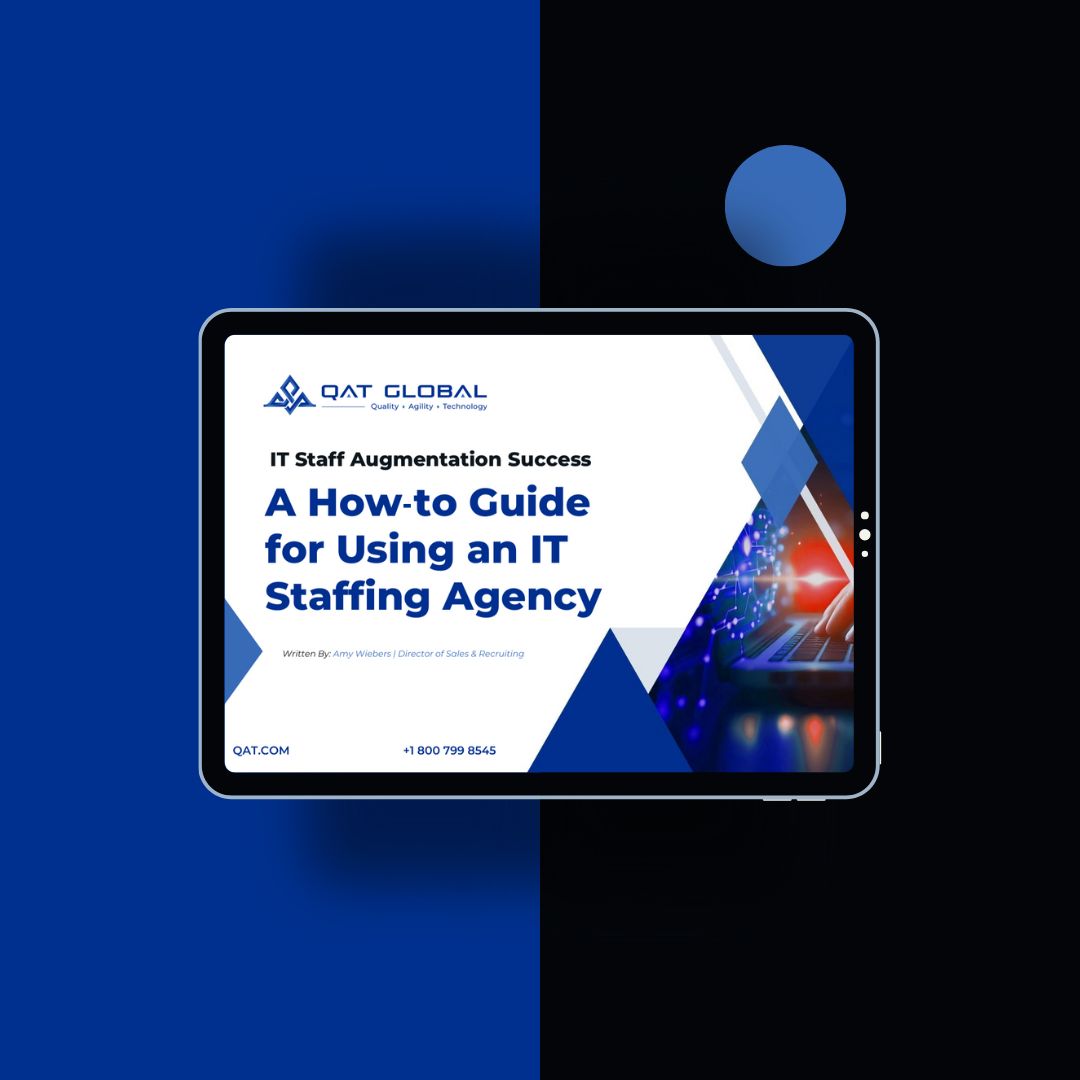How High-Performing Tech Teams Use Multi-Layered Screening to Eliminate Mis-Hires and Outpace the Competition
From the Desk of Amy Wiebers
Director of Recruiting & Sales | 30 Years in Enterprise IT Staffing & Talent Strategy
Let’s be real—hiring great tech talent isn’t what it used to be. The stakes are higher, the competition is tougher, and the cost of a mis-hire? IT talent acquisition is brutal.
Over the years, I’ve worked with thousands of IT leaders—from high-growth startups to global enterprises—and they all want the same IT talent acquisition challenges: skilled people who ramp up fast, fit the team, and stick around. But most are still relying on the same old résumé + interview + gut feel combo to make it happen.
If that sounds familiar, it’s time to level up.
In this guide, I’m going to walk you through the multi-layered screening process we’ve refined at QAT Global—one that’s helped clients consistently master IT talent acquisition, hire smarter, scale faster, and actually build the kind of teams that deliver real results.
What Is Multi-Layered Screening—and Why It Works
Multi-layered screening isn’t about making hiring more complex. It’s about making it smarter.
Multi-layered screening means evaluating a candidate holistically—beyond technical credentials—to ensure:
- They have the skills and the mindset.
- They know the tools and how to navigate your team dynamic.
- They’re not just available—they’re engaged and adaptable.
Think of it like this: Each layer removes risk. All layers combined build certainty. And when it comes to IT talent acquisition, reducing uncertainty is everything.
Here’s what we look for:
Layer 1: Technical Proficiency
Can they architect, execute, and troubleshoot with confidence?
Ask: “Walk me through a recent implementation using [specific technology]. What were your constraints, and how did you solve for them?”
Layer 2: Problem-Solving Ability
Can they navigate ambiguity and think critically when the roadmap shifts?
Ask: “Describe a situation where a project hit a wall. What did you do to move it forward?”
Layer 3: Communication & Team Collaboration
Can they bridge technical and business conversations? Are they coachable?
Ask: “Tell me how you explain technical decisions to a non-technical stakeholder.”
Layer 4: Cultural & Behavioral Alignment
Will they elevate your team or create drag?
Ask: “What type of work culture brings out your best performance?”
Layer 5: Work History & Motivation
Are they looking for a job—or a mission they can align with?
Ask: “Why did you leave your last few roles, and what are you hoping to find next?”
Layer 6: Adaptability & Growth Mindset
Can they learn, evolve, and stay productive in the face of change?
Ask: “Tell me about a time you had to learn something completely new under pressure.”
What the Best Teams Get Right
(And Most Don’t)
Quick-Start Implementation Guide for Smart Teams
Here’s how to operationalize this framework starting today:
- Calibrate – Align internally on what great looks like (skills, soft skills, culture).
- Customize – Map your interview questions to each layer. No more winging it.
- Train – Get all interviewers aligned on how to assess each layer.
- Document – Capture detailed notes and insights from each interview to understand how candidates align with technical, cultural, and communication expectations—not just initial impressions.
- Refine – Debrief post-hire: what signals predicted success? What didn’t?
Smarter IT Talent Acquisition Isn’t Optional Anymore
Today’s top engineers have more choices than ever. If your process doesn’t screen with surgical precision, you’ll lose them—either before the offer or shortly after onboarding.
This framework ensures you:
- Eliminate mis-hires before they cost you time, morale, and momentum.
- Accelerate delivery by placing talent that contributes faster.
- Increase retention by hiring people aligned with your mission.
It’s not just about hiring faster. It’s about hiring better—and building a team that scales your business, not just your backlog.
My Final Word
You don’t have to gamble on talent. You just need the right filters.
I built this framework after watching hundreds of leaders learn the hard way. You don’t have to.
Use it. Share it. And start building an IT talent acquisition process that actually works.
BONUS: The Smart Screening Checklist
Use this 6-point checklist to pressure test every candidate before the offer.
Technical Proficiency
Do they demonstrate hands-on, real-world experience with the core tech stack?
☐ Can they walk through a full project lifecycle?
☐ Did they discuss architecture, not just execution?
Problem-Solving
Are they resourceful under pressure and able to navigate ambiguity?
☐ Do they describe obstacles they’ve overcome?
☐ Do they offer frameworks, not just anecdotes?
Communication & Team Collaboration
Can they translate complexity and work across disciplines?
☐ Do they adapt language for their audience?
☐ Do they share examples of resolving team friction?
☐ If English is their second language, are they able to effectively communicate in English?
Culture & Behavioral Fit
Will they integrate into your team’s unique pace and values?
☐ Are their preferred environments similar to yours?
☐ Do they elevate or disrupt collaboration?
Work History & Motivation
Do their career choices reflect intentionality and growth?
☐ Can they explain their transitions with clarity?
☐ Are their goals aligned with your opportunity?
Adaptability & Learning Agility
Are they able to quickly absorb, pivot, and thrive in new contexts?
☐ Do they give examples of learning under pressure?
☐ Do they show curiosity and coachability?
- How High-Performing Tech Teams Use Multi-Layered Screening to Eliminate Mis-Hires and Outpace the Competition
- What Is Multi-Layered Screening—and Why It Works
- What the Best Teams Get Right
- Quick-Start Implementation Guide for Smart Teams
- Smarter IT Talent Acquisition Isn’t Optional Anymore
- My Final Word
- BONUS: The Smart Screening Checklist

















